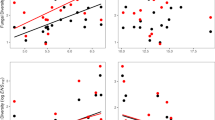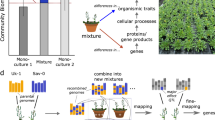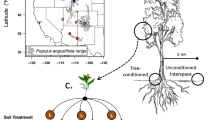Abstract
Overyielding, the high productivity of multispecies plant communities, is commonly seen as the result of plant genetic diversity. Here we demonstrate that biodiversity–ecosystem functioning relationships can emerge in clonal plant populations through interaction with microorganisms. Using a model clonal plant species, we found that exposure to volatiles of certain microorganisms led to divergent plant phenotypes. Assembling communities out of plants associated with different microorganisms led to transgressive overyielding in both biomass and seed yield. Our results highlight the importance of belowground microbial diversity in plant biodiversity research and open new avenues for precision ecosystem management.
This is a preview of subscription content, access via your institution
Access options
Access Nature and 54 other Nature Portfolio journals
Get Nature+, our best-value online-access subscription
$29.99 / 30 days
cancel any time
Subscribe to this journal
Receive 12 digital issues and online access to articles
$119.00 per year
only $9.92 per issue
Buy this article
- Purchase on Springer Link
- Instant access to full article PDF
Prices may be subject to local taxes which are calculated during checkout


Similar content being viewed by others
Data availability
All data that support the findings of this study are available via Figshare at https://figshare.com/s/1094376bbb9259e1b18e.
References
Fargione, J. et al. From selection to complementarity: shifts in the causes of biodiversity–productivity relationships in a long-term biodiversity experiment. Proc. R. Soc. B 274, 871–876 (2007).
Craven, D. et al. Multiple facets of biodiversity drive the diversity–stability relationship. Nat. Ecol. Evol. 2, 1579–1587 (2018).
Loreau, M. & Hector, A. Partitioning selection and complementarity in biodiversity experiments. Nature 412, 72–76 (2001).
Isbell, F. et al. Biodiversity increases the resistance of ecosystem productivity to climate extremes. Nature 526, 574–577 (2015).
Schmid, B., Hector, A., Saha, P. & Loreau, M. Biodiversity effects and transgressive overyielding. J. Plant Ecol. 1, 95–102 (2008).
Marquard, E. et al. Plant species richness and functional composition drive overyielding in a six-year grassland experiment. Ecology 90, 3290–3302 (2009).
Barry, K. E. et al. The future of complementarity: disentangling causes from consequences. Trends Ecol. Evol. 34, 167–180 (2019).
Des Roches, S. et al. The ecological importance of intraspecific variation. Nat. Ecol. Evol. 2, 57–64 (2018).
Chen, Y. et al. Drought-exposure history increases complementarity between plant species in response to a subsequent drought. Nat. Commun. 13, 3217 (2022).
Guimarães-Steinicke, C. et al. Biodiversity facets affect community surface temperature via 3D canopy structure in grassland communities. J. Ecol. 109, 1969–1985 (2021).
Panke-Buisse, K., Poole, A. C., Goodrich, J. K., Ley, R. E. & Kao-Kniffin, J. Selection on soil microbiomes reveals reproducible impacts on plant function. ISME J. 9, 980–989 (2015).
Bartoli, C. et al. In situ relationships between microbiota and potential pathobiota in Arabidopsis thaliana. ISME J. 12, 2024–2038 (2018).
O’Brien, A. M., Ginnan, N. A., Rebolleda-Gómez, M. & Wagner, M. R. Microbial effects on plant phenology and fitness. Am. J. Bot. 108, 1824–1837 (2021).
Vandenkoornhuyse, P., Quaiser, A., Duhame, M., Le Van, A. & Dufresne, A. The importance of the microbiome of the plant holobiont. New Phytol. 206, 1196–1206 (2015).
Ravanbakhsh, M., Kowalchuk, G. A. & Jousset, A. Targeted plant hologenome editing for plant trait enhancement. New Phytol. 229, 1067–1077 (2021).
Ravanbakhsh, M., Kowalchuk, G. A. & Jousset, A. Root-associated microorganisms reprogram plant life history along the growth–stress resistance tradeoff. ISME J. 13, 3093–3101 (2019).
Roughgarden, J. Holobiont evolution: population genetic theory for the hologenome. Am. Nat. 201, 763–778 (2023).
Wagg, C., Schlaeppi, K., Banerjee, S., Kuramae, E. E. & van der Heijden, M. G. A. Fungal-bacterial diversity and microbiome complexity predict ecosystem functioning. Nat. Commun. 10, 4841 (2019).
Wagg, C., Bender, S. F., Widmer, F. & van der Heijden, M. G. A. Soil biodiversity and soil community composition determine ecosystem multifunctionality. Proc. Natl Acad. Sci. USA 111, 5266–5270 (2014).
Wei, Z. et al. Initial soil microbiome composition and functioning predetermine future plant health. Sci. Adv. 5, eaaw0759 (2019).
Sharifi, R. & Ryu, C. M. Revisiting bacterial volatile-mediated plant growth promotion: lessons from the past and objectives for the future. Ann. Bot. 122, 349–358 (2018).
Bailly, A. & Weisskopf, L. The modulating effect of bacterial volatiles on plant growth: current knowledge and future challenges. Plant Signal. Behav. 7, 79–85 (2012).
Schmidt, R. & Saha, M. Infochemicals in terrestrial plants and seaweed holobionts: current and future trends. New Phytol. 229, 1852–1860 (2021).
Armas, C., Ordiales, R. & Pugnaire, F. I. Measuring plant interactions: a new comparative index. Ecology 85, 2682–2686 (2004).
Raza, W., Wei, Z., Jousset, A., Shen, Q. & Friman, V. P. Extended plant metarhizobiome: understanding volatile organic compound signaling in plant-microbe metapopulation networks. mSystems 6, e00849-21 (2021).
Marquard, E. et al. Changes in the abundance of grassland species in monocultures versus mixtures and their relation to biodiversity effects. PLoS ONE 8, e75599 (2013).
Zuppinger-Dingley, D. et al. Selection for niche differentiation in plant communities increases biodiversity effects. Nature 515, 108–111 (2014).
Eisenhauer, N. et al. in Advances in Ecological Research (eds Eisenhauer, N. et al.) Ch. 1 (Academic Press, 2019).
Wright, A. J., Wardle, D. A., Callaway, R. & Gaxiola, A. The overlooked role of facilitation in biodiversity experiments. Trends Ecol. Evol. 32, 383–390 (2017).
Dimitrakopoulos, P. G. & Schmid, B. Biodiversity effects increase linearly with biotope space. Ecol. Lett. 7, 574–583 (2004).
Schulz-Bohm, K., Martín-Sánchez, L. & Paolina, G. Microbial volatiles: small molecules with an important role in intra- and inter-kingdom interactions. Front. Microbiol. 8, 2484 (2017).
Raza, W. et al. Bacterial community richness shifts the balance between volatile organic compound-mediated microbe–pathogen and microbe–plant interactions. Proc. R. Soc. B 287, 20200403 (2020).
Piechulla, B., Lemfack, M. C. & Kai, M. Effects of discrete bioactive microbial volatiles on plants and fungi. Plant Cell Environ. 40, 2042–2067 (2017).
Barry, K. E. et al. Limited evidence for spatial resource partitioning across temperate grassland biodiversity experiments. Ecology 101, e02905 (2020).
Eisenhauer, N. et al. Biotic interactions, community assembly, and eco-evolutionary dynamics as drivers of long-term biodiversity–ecosystem functioning relationships. Res. Ideas Outcomes 5, e47042 (2019).
Vos, M., Wolf, A. B., Jennings, S. J. & Kowalchuk, G. A. Micro-scale determinants of bacterial diversity in soil. FEMS Microbiol. Rev. 37, 936–954 (2013).
Bordenstein, S. R. & Theis, K. R. Host biology in light of the microbiome: ten principles of holobionts and hologenomes. PLoS Biol. 13, e1002226 (2015).
Qiu, J. & Cardinale, B. J. Scaling up biodiversity–ecosystem function relationships across space and over time. Ecology 101, e03166 (2020).
Paquette, A. et al. TreeDivNet, a million and more trees for science. Nat. Ecol. Evol. 2, 763–766 (2018).
Hu, J. et al. Rhizosphere microbiome functional diversity and pathogen invasion resistance build up during plant development. Environ. Microbiol. 22, 5005–5018 (2020).
Murashige, T. & Skoog, F. A revised medium for rapid growth and bio assays with tobacco tissue cultures. Physiol. Plant. 15, 473–497 (1962).
Wick, R. R. et al. Trycycler: consensus long-read assemblies for bacterial genomes. Genome Biol. 22, 266 (2021).
Meier-Kolthoff, J. P., Sardà Carbasse, J., Peinado-Olarte, R. L. & Göker, M. TYGS and LPSN: a database tandem for fast and reliable genome-based classification and nomenclature of prokaryotes. Nucleic Acid Res. 50, D801–D807 (2022).
Funk, J. L. et al. Revisiting the Holy Grail: using plant functional traits to understand ecological processes. Biol. Rev. 92, 1156–1173 (2017).
He, H. et al. Interaction between parental environment and genotype affects plant and seed performance in Arabidopsis. J. Exp. Bot. 65, 6603–6615 (2014).
Easlon, H. M. & Bloom, A. J. Easy leaf area: automated digital image analysis for rapid and accurate measurement of leaf area. Appl. Plant Sci. 2, 1400033 (2014).
Sneath, P. H. & Sokal, R. R. Numerical Taxonomy: The Principles and Practice of Numerical Classification 1st edn (W. H. Freeman, 1973).
Schmid, B., Baruffol, M., Wang, Z. & Niklaus, P. A. A guide to analyzing biodiversity experiments. J. Plant Ecol. 10, 91–110 (2017).
Jousset, A., Schulz, W., Scheu, S. & Eisenhauer, N. Intraspecific genotypic richness and relatedness predict the invasibility of microbial communities. ISME J. 5, 1108–1114 (2011).
Acknowledgements
This study was supported by the National Natural Science Foundation of China (42350610257 (W.R.), 42377124 (W.R.), 42325704 (Z.W.), 42090064 (Q.S.), 42090062 (G.J.), 42007038 (G.J.) and 42277113 (Z.W.)), the Fundamental Research Funds for the Central Universities (XUEKEN2023044 (W.R.), KYT2023001 (Z.W.), KYCXJC2023007 (G.J.)), the Natural Science Foundation of Jiangsu Province (BK20230102 (G.J.)) the European Union’s Horizon 2020 research and innovation program under the Marie Skłodowska-Curie grant (838710-ReproDev (W.R.)), iDiv funded by the German Research Foundation (DFG–FZT 118, 202548816 (N.E.)) and the Jena Experiment funded by the DFG (FOR 5000). We thank R. Neher, R. Tschannen and S. Cretoiu for support with genome sequencing of bacterial strains used in this study.
Author information
Authors and Affiliations
Contributions
W.R., Z.W. and A.J. designed the experiments. W.R. carried out the experiments. W.R., G.J., Y.H. and A.J. analysed the data and wrote the manuscript. G.J., Z.W., G.A.K., Q.S. and N.E. revised the manuscript.
Corresponding authors
Ethics declarations
Competing interests
The authors declare no competing interests.
Peer review
Peer review information
Nature Ecology & Evolution thanks Forest Isbell and the other, anonymous, reviewer(s) for their contribution to the peer review of this work. Peer reviewer reports are available.
Additional information
Publisher’s note Springer Nature remains neutral with regard to jurisdictional claims in published maps and institutional affiliations.
Extended data
Extended Data Fig. 1 Experimental setup of the divided Petri plate for the exposure of clonal plants to bacterial volatiles.
Petri plate has two compartments divided by a wall, which provides physical separation of both compartments but allows the exchange of gases. In one compartment containing Murashige and Skoog agar medium, three seedlings of Arabidopsis were placed, while in the second compartment containing minimal salt agar medium, three 5 µl drops of bacterial culture were added at a distance of 3 cm from each other. Later, the plate was covered with a lid, sealed with parafilm and incubated for one week.
Extended Data Fig. 2 Comparison of genome sequences and volatile compounds produced by four bacterial strains.
(a) Genome to genome distance of four bacterial strains used for volatile compounds-mediated phenotypic induction of Arabidopsis thaliana Col-0. In the heatmap, higher intensity of red color represents higher genome-to-genome distance. (b) Principal component analysis (PCA) based on the relative peak area of volatile compounds produced by four bacterial strains in triplicate (n = 12). The volatile compounds analysis was conducted using gas chromatography-mass spectrometry (GC-MS). The four bacterial strains used in the study are Pseudoxanthomonas mexicana F12, Chryseobacterium daecheongense F23, Pseudoxanthomonas mexicana F31 and Pseudoxanthomonas sp. F37.
Extended Data Fig. 3 Effect of plant density on the four measured life-history traits (plant height, rosette area, aboveground biomass, number of siliques) with and without previous exposure to the volatile compounds produced by four different bacteria.
Plants were exposed to the volatile compounds of four different bacteria during early life for one-week (representing four different phenotypes); later, bacteria were removed, and plants were placed together in pots at 1-, 2-, and 4-plants density (PD) and 1-, 2-, and 4-plants phenotypic diversity (HD) levels, respectively. In scatterplot panels, each data point represents the mean value of quadruplicates (n = 28). The colors of data points and regression lines correspond to the plant phenotypic diversity levels.
Extended Data Fig. 4 Development of plant height and rosette area after 10 days, 25 days and 35 days with and without previous exposure to the volatile compounds of four different bacteria.
Plants were exposed to volatile compounds of four different bacteria during early life for one-week (representing four different phenotypes); later, bacteria were removed, and plants were placed together in pots at 1-, 2- and 4-plants density and 1- 2- and 4-plants phenotypic diversity levels, respectively. In scatterplot panels, each data point represents the mean value of quadruplicates (n = 28). The colors of data points and regression lines correspond to the plant phenotypic diversity levels.
Extended Data Fig. 5 Pairwise interactions between plant phenotypes for the four-plant life-history traits (plant height, rosette area, aboveground biomass, number of siliques).
Pairwise interactions between plant phenotypes were determined as the relative interaction index (RII) separately at 2- and 4-plants density levels using only a diversity level of 2-phenotypes for each of the four life-history traits. Pairwise RII was defined as the performance of each phenotype in the presence of another phenotype, relative to its performance in monoculture at the same plant density. Red arrows stand for competition and green arrows stand for facilitation. Arrow breadth is proportional to |RII|. Only arrows showing significant differences according to the two-tailed T-test at P < 0.05 are included.
Extended Data Fig. 6 Sampling effect of plant phenotypes on life-history traits (plant height, rosette area, aboveground biomass, number of siliques).
Sampling effect was determined at the highest tested density of four plants per pot, covering diversity levels of 2- and 4-phenotypes. It was calculated by carrying out two-tailed T-test comparing the performance of communities containing the phenotype relative to those lacking it. In the heatmap, the higher intensity of green color represents a significant sampling effect while the higher intensity of red color represents a nonsignificant sampling effect based on P values provided. The four bacterial strains used to induce plant phenotypes are Pseudoxanthomonas mexicana F12, Chryseobacterium daecheongense F23, Pseudoxanthomonas mexicana F31 and Pseudoxanthomonas sp. F37.
Supplementary information
Supplementary Information
Supplementary Text and Tables 1–4.
Supplementary Data
Supplementary Data 1. Volatile compounds-mediated plant growth promoting potential of bacterial strains isolated from the tomato rhizosphere at the flowering stage. Supplementary Data 2. Identification of volatile compounds produced by four bacterial strains used for volatile compounds-mediated phenotypic induction of Arabidopsis thaliana Col-0.
Rights and permissions
Springer Nature or its licensor (e.g. a society or other partner) holds exclusive rights to this article under a publishing agreement with the author(s) or other rightsholder(s); author self-archiving of the accepted manuscript version of this article is solely governed by the terms of such publishing agreement and applicable law.
About this article
Cite this article
Raza, W., Jiang, G., Eisenhauer, N. et al. Microbe-induced phenotypic variation leads to overyielding in clonal plant populations. Nat Ecol Evol 8, 392–399 (2024). https://doi.org/10.1038/s41559-023-02297-1
Received:
Accepted:
Published:
Issue Date:
DOI: https://doi.org/10.1038/s41559-023-02297-1



